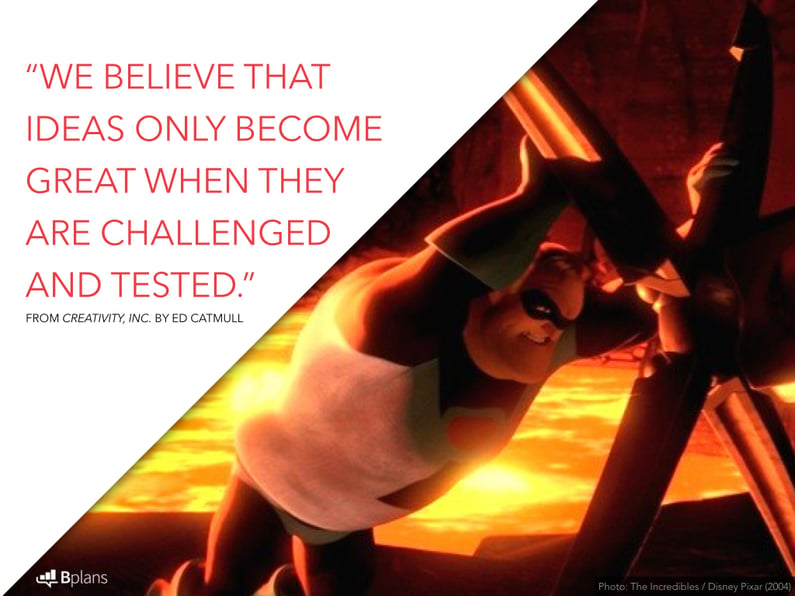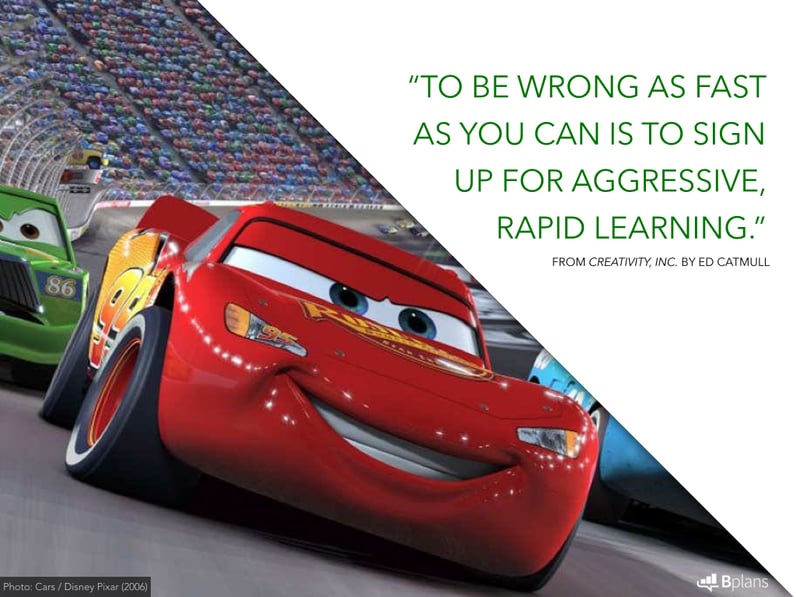Edwin Catmull left Lucasfilm in 1986 when the firm’s digital division was purchased by Steve Jobs, marking the birth of Pixar. After Disney acquired Pixar in 2006, Catmull and Lasseter were tasked with reinvigorating Disney animation studios. Creativity, Inc. is Ed’s story. He discusses many of the blocks to creativity along with the active steps we can take to protect the creative process, deal with uncertainty, instability, lack of candor and the things we cannot see.
Here are some of the principles Ed and Pixar have developed to enable a healthy creative culture:
Give a good idea to a mediocre team, and they will screw it up. Give a mediocre idea to a great team, and they will either fix it or come up with something better. If you get the team right, chances are that they’ll get the ideas right.
Always try to hire people who are smarter than you. Always take a chance on better, even if it seems like a potential threat. When looking to hire people, give their potential to grow more weight than their current skill level. What they will be capable of tomorrow is more important than what they can do today.
If there are people in your organization who feel they are not free to suggest ideas, you lose. Do not discount ideas from unexpected sources. Inspiration can, and does, come from anywhere. It isn’t enough merely to be open to ideas from others. Engaging the collective brainpower of the people you work with is an active, ongoing process. As a manager, you must coax ideas out of your staff and constantly push them to contribute. There are many valid reasons why people aren’t candid with one another in a work environment. Your job is to search for those reasons and then address them.
There is nothing quite as effective, when it comes to shutting down alternative viewpoints, as being convinced you are right. Likewise, if someone disagrees with you, there is a reason. Our first job is to understand the reasoning behind their conclusions. Further, if there is fear in an organization, there is a reason for it. Our job is (a) to find what’s causing it, (b) to understand it, and (c) to try to root it out.
In general, people are hesitant to say things that might rock the boat. Braintrust meetings, dailies, postmortems, and Notes Day are all efforts to reinforce the idea that it is okay to express yourself. All are mechanisms of self-assessment that seek to uncover what’s real.
If there is more truth in the hallways than in meetings, you have a problem. Many managers feel that if they are not notified about problems before others are or if they are surprised in a meeting, then that is a sign of disrespect. Get over it.
Careful “messaging” to downplay problems makes you appear to be lying, deluded, ignorant, or uncaring. Sharing problems is an act of inclusion that makes employees feel invested in the larger enterprise.
The first conclusions we draw from our successes and failures are typically wrong. Measuring the outcome without evaluating the process is deceiving. Do not fall for the illusion that by preventing errors, you won’t have errors to fix. The truth is, the cost of preventing errors is often far greater than the cost of fixing them.
Change and uncertainty are part of life. Our job is not to resist them but to build the capability to recover when unexpected events occur. If you don’t always try to uncover what is unseen and understand its nature, you will be ill prepared to lead.
Similarly, it is not the manager’s job to prevent risks. It is the manager’s job to make it safe to take them. Failure isn’t a necessary evil. In fact, it isn’t evil at all. It is a necessary consequence of doing something new.
Trust doesn’t mean that you trust that someone won’t screw up. It means you trust them even when they do screw up. The people ultimately responsible for implementing a plan must be empowered to make decisions when things go wrong, even before getting approval. Finding and fixing problems is everybody’s job. Anyone should be able to stop the production line.
The desire for everything to run smoothly is a false goal. It leads to measuring people by the mistakes they make rather than by their ability to solve problems. Don’t wait for things to be perfect before you share them with others. Show early and show often. It’ll be pretty when we get there, but it won’t be pretty along the way. And that’s as it should be.
A company’s communication structure should not mirror its organizational structure. Everybody should be able to talk to anybody.
Be wary of making too many rules. Rules can simplify life for managers, but they can be demeaning to the 95 percent who behave well. Don’t create rules to rein in the other 5 percent—address abuses of common sense individually. This is more work but ultimately healthier.
Imposing limits can encourage a creative response. Excellent work can emerge from uncomfortable or seemingly untenable circumstances. Engaging with exceptionally hard problems forces us to think differently.
An organization, as a whole, is more conservative and resistant to change than the individuals who comprise it. Do not assume that general agreement will lead to change—it takes substantial energy to move a group, even when all are on board.
Protect the future, not the past. Our job as managers in creative environments is to protect new ideas from those who don’t understand that in order for greatness to emerge, there must be phases of not-so-greatness. New crises are not always lamentable—they test and demonstrate a company’s values. The process of problem-solving often bonds people together and keeps the culture in the present.
Excellence, quality, and good should be earned words, attributed by others to us, not proclaimed by us about ourselves. Do not accidentally make stability a goal. Balance is more important than stability.
Don’t confuse the process with the goal. Working on our processes to make them better, easier, and more efficient is an indispensable activity and something we should continually work on—but it is not the goal. Making the product great is the goal.
The book is one of the best I’ve read this year with applications far beyond writing and illustrating children’s stories. For more, check out this Conversation with Ed Catmull at Stanford or How Pixar Fosters Collective Creativity from the September 2008 issue of Harvard Business Review.



